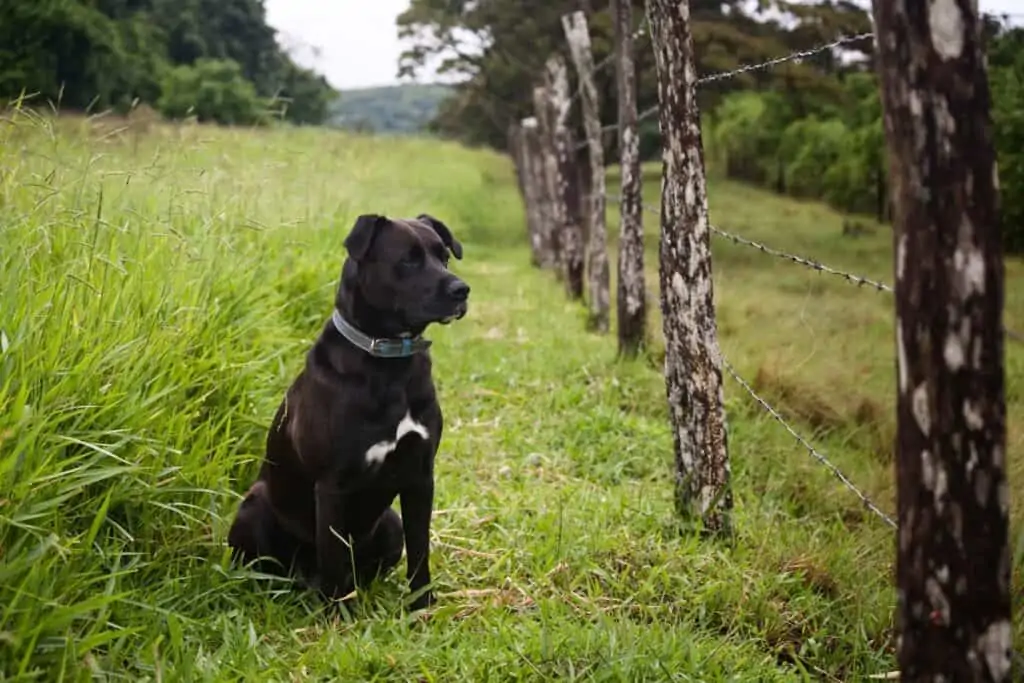DIY Chicken Wire for Dog Fence
A fenced-in yard is an excellent addition to your home and for your pups. A dog fence not only keeps your pets safe and from running away or getting lost, but it also allows them the freedom to run, get some exercise or energy out, and play.
You can use many types of fences to make your fenced-in yard for your dog, but chicken wire is one of the best options for a DIY dog fence. Keep reading to learn more about why dog fences are essential in the first place and how to install a chicken wire dog fence.
The Importance of Dog Fences
A fenced-in backyard is an ideal choice for your canine. A fence allows your dog to have the freedom to play but also keeps your beloved pup safe.

- Fences prevent your dog from getting lost. Some dogs love to explore or are easily caught up by the many scents in their air and follow their nose until they are far away from home. Fences help prevent your pup from getting out and getting lost.
- Fences prevent your dog from getting in contact with other dogs or people. Not all dogs are friendly, and not all dogs like other people. Fences help avoid dog fights and unwanted interactions with people. In addition, fences prevent dogs from contacting each other and help protect them from unwanted breeding. This protection is especially needed if your dog is not spayed or neutered.
- Finally, fences help provide protection from predators or burglars. Some small dogs may be considered a tasty meal for a roaming coyote. There are also people who steal dogs and sell them on the black market. A physical fence will help protect your dog from these dangers.
Fenced-in backyards are preferred over other types of restraints, like tying your dog to a tree or chain on a stake. Those options can become dangerous, especially if your dog becomes tangled. There is also nothing to stop your dog from running off if it slips out of its collar.
A well-fenced backyard not only prevents your dog from escaping and getting lost but also prevents your pup from the danger of the outdoors and other dogs and people. Fences are always a good idea!
Why Chicken Wire?

Chicken wire is excellent for building your dog fence because it is inexpensive and easy to work with.
Chicken wire also has small enough holes that your pup won’t be able to slip through them. When installed properly, it is also a great tool to stop your dog from digging holes in your yard or digging under the fence.
A properly installed chicken wire fence can also last for years. This sturdy fence is an excellent choice for most dogs. You can use chicken wire to contain a variety of breeds and sizes of dogs. If installed properly, it can be strong enough to hold 50-70 pound dogs but can also be used for tiny Chihuahuas.
Cons of a Chicken Wire Fence
Unfortunately, a chicken wire dog fence is not for everyone or every yard. They are great for small yards, as they can be physically taxing to install by oneself. Larger yards will take a lot of work and physical exertion.
If the chicken wire fence is not high enough, your dog may be able to jump over it.
Even though a chicken wire fence will keep most intruders and critters out, smaller animals, like snakes, will still be able to slink through.
If you live in a neighborhood or subdivision, there may be rules on the types of fencing you can install for your backyard, and chicken wire may not be allowed.
A dog fence made from chicken wire will only be as strong as your support posts, so choose wisely!
Supplies You Will Need
You should be able to find everything you need to build a chicken wire dog fence from your local home improvement store. Supplies you’ll need include:
- Rolls of chicken wire
- Posts – metal T-posts are strongest, but you can also use wooden posts
- Baling wire, wire ties, or nails – these will be used to attach the chicken wire to the posts
- Sledgehammer, if using metal T-posts
- Concrete and shovel, if using wooden posts
The amount of chicken wire and the number of posts you will need depend on the size of the area you want to fence in. Metal T-posts can cost anywhere from $5-$10, depending on size and height. Wooden posts can cost about the same, at $4-$9 each. Chicken wire can run from $0.35 to $1 per linear foot. Added up, building your chicken wire fencing is still cheaper than having a commercial fence professionally installed.
How To Install a Chicken Wire Dog Fence
Here are some brief instructions for installing your own chicken wire dog fence:
- Plan out where you want your fence to go. Mark the area with spray paint, if it’s a small yard, or mark out where the stakes should go. Stakes should be placed 6-8ft apart.
- If using metal t-posts, pound them into the ground.
- If using wooden or other types of posts, set them in concrete (see below).
- Attach the chicken wire to the posts with wire tires, baling wire, or nails. Make sure to stretch the chicken wire as tightly as possible against the posts. You may require the help of another person for this step.
- Attach the chicken wire at the top of each post, in the middle of each post, and at the bottom of each post. If your dog likes to dig, you can also bury six inches of chicken wire to prevent your dog from digging under the fence.
How to Set Wooden Posts
Here are some brief instructions for installing wooden posts and setting them with concrete:
- Gather your supplies.
- Wooden posts
- Concrete mix – quick-set is recommended, but you can also use regular concrete
- Bucket with water
- Shovel
- Mark out with spray paint where each post should go.
- Dig a hole, at least two feet deep, where each mark is.
- Place each wooden post, centered, in each hole. It sometimes helps to put rocks in the bottom of the hole and then place the post on top of the rocks. This is where it also helps to have another person helping you.
- With the post in the hole, start filling the hole with cement. Follow the manufacturer’s instructions on the bag of concrete mix on the water to concrete ratio. In general, you can fill the hole partially with concrete mix, add some water, and mix the concrete in the hole. Pack the cement and make sure your post is straight.
- Cover the concrete mixture with the dirt from digging the hole and place rocks around the bottom of the post to keep it straight while the concrete sets.
- Repeat this process to set each wooden post.
- Depending on whether you used regular concrete or quick-set concrete, your posts will either be fully set after a day or after an hour.

Tips for Installing a Chicken Wire Dog Fence
Here are some quick tips for installing your own chicken wire dog fence:
- Having a second set of hands is helpful, especially when installing wooden fence posts and setting them in concrete or when attaching chicken wire to the posts, to help stretch the wire as tight as possible.
- The closer together that the posts are placed, the stronger the fence will be. 6-8ft apart is a good rule of thumb, but you can bring them closer if you need a stronger fence.
- A popular design is a rectangular-shaped fence area, with wooden posts in the corners and metal t-posts used between corner posts. This design is also very solid.
Wrapping Up
A chicken wire dog fence is a great option for many dog owners, as it is easy to work with and a cheaper alternative to traditional fences. This article provides instructions for installing your own chicken wire fence and fence posts. Hopefully, your pup will enjoy its new yard!
